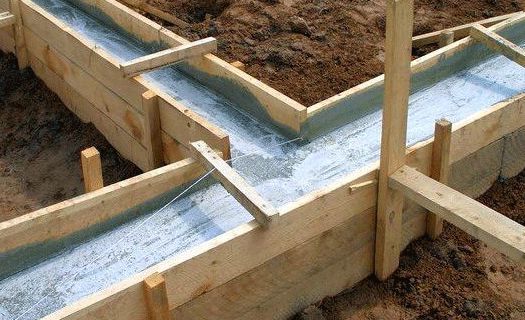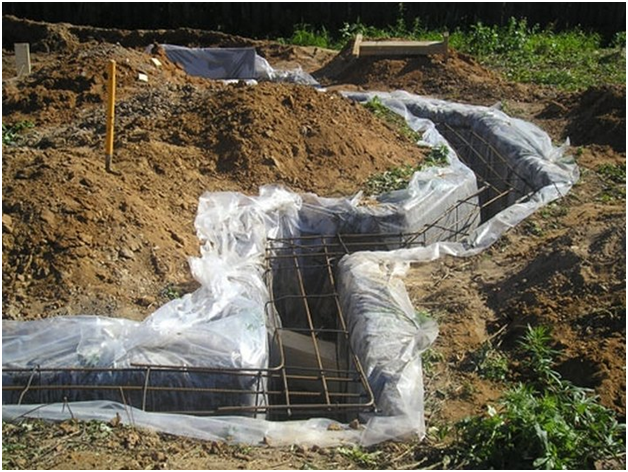The device of the slotted foundation for the house
A slotted foundation is inherently one of the options for a strip base. This option is used for low-rise buildings, being a kind of adaptation of the traditional to the limited opportunities of a private developer.
General description of technology
First of all, slotted foundations differ from other varieties in that there is almost no formwork in their design. A trench is dug along the perimeter of the future house, the walls of which play its role. Hence the name of this technology - since the concrete is poured not into the previously prepared formwork, but into a trench ("gap") in the ground.
 Clay soils are most suitable for pouring this type of base.
Clay soils are most suitable for pouring this type of base. This option can be considered optimal only if a number of conditions are met:
- If the house is being built on clay soil.
- If the groundwater is deep enough (deeper than the bottom level of the base).
- If the seasonal heaving of the soil is small.
Due to the limitations in use, this technique should be used very carefully. First, you need to carefully examine all the characteristics of the soil on the site.
Clay soil retains its shape in the best possible way, without crumbling to the bottom of the trench. Therefore, it is on such soils that it is best to build a slotted foundation for a private house. On sandy soils or on soils rich in humus (chernozem), it is not worth resorting to such a technology.
The fact is that the weak edges of trenches dug on such soils will invariably crumble inward when pouring concrete. This will, firstly, deteriorate the quality of concrete. Secondly, an unnecessary organic layer will form between the concrete and the gravel bed.
Advantages and disadvantages
Like any other construction technology, slotted foundations have their pros and cons. Therefore, the use of this technique can be both justified in one case, and unacceptable in another.
disadvantages
 This technology is not used in industrial construction, because it is not adopted by SNiP
This technology is not used in industrial construction, because it is not adopted by SNiP Let's start with the cons. It should be noted right away that such a technique contradicts building codes - in particular, clause 22.13330 of SNiP.
As a result, a description of such a technique cannot be found in the official construction literature. The slit foundation was invented long ago, but did not receive official recognition from construction technologists.
The fact is that such a technique cannot guarantee the strength of the base for the house required by building standards. As a result, this method of constructing foundations is the lot of private developers - it is not officially allowed even for the construction of light one-story structures.
Among other disadvantages are the restrictions already listed above for use on clay and non-porous soils. These special conditions for the use of slot technology are the main limitations in its widespread use. The fact is that clayey soils themselves are very water-saturated. Therefore, in the cold season, they are extremely susceptible to heaving, which leads to deformations and even destruction of the foundation.
This factor is especially relevant for slotted foundations: due to the strong lateral adhesion of concrete to the surrounding soil, the base is subject to seasonal "walking" when the soil freezes. And this is already a serious drawback for the foundation, and can lead to distortion and destruction of the house.
Advantages
 In some cases, it is worth abandoning the slotted base in favor of a more reliable tape
In some cases, it is worth abandoning the slotted base in favor of a more reliable tape But the foundations, erected without the use of formwork, have their own indisputable advantages. First of all, this is a reduction in the cost of construction by eliminating the construction of formwork, which leads to less labor costs and reduces the total construction time.
If the use of slot technology is possible at a given construction site, then this can be an excellent way to optimize financial costs. As practice shows, the rejection of internal formwork also allows you to reduce the labor and time spent on pouring the foundation by almost half.
When choosing such a technology, do not forget that the miser pays twice. If there are any doubts about the advisability of a slotted base for a house under construction, then it would be best to abandon it in favor of more reliable technologies.
However, there are several options to avoid the restrictions imposed on the use of this method when building foundation foundations for a house. To minimize its "walking" when the surrounding soil freezes, it is enough to deepen the base of the foundation below the freezing point.
For different regions, the depth of winter freezing of the soil is different - for example, for central Russia it is about 0.8-1.2 m. For the same purpose, an effective drainage system is being built around the foundation of the future house, which allows excess subsurface moisture to be removed.
Stages of the construction of a slotted foundation
The technology for the device of slotted foundations is not much different from the construction of classic strip foundations. However, it also has its own individual characteristics.
Excavation
 Digging a pit can be done using technology or manually
Digging a pit can be done using technology or manually The first stage is to carry out the necessary earthworks. First of all, the top layer saturated with organic matter is removed.
If necessary, it can be used to level the horizon of the construction site. After that, the markup is done. In accordance with the project of the house, pegs are hammered on the ground and axial lines are pulled over them, which serve as landmarks.
Then, in accordance with the center lines, a trench is dug under the future foundation of the house. Since, when pouring concrete, its walls will replace the formwork, special attention should be paid to it. The width of the trench should correspond to the width of the foundation - that is, be 30-60 cm. Its edges should be dense and not crumbling, if it rained on the eve of pouring the concrete and softened the clay walls of the trench, then they must be cut to a dense soil.
At the bottom of the trench, a cushion of crushed stone, gravel or coarse sand is built, with a thickness of about 7-10 cm. It is advisable to compact the sand cushion with a manual rammer or vibrating plate. When arranging a buried slotted foundation, it is quite possible to do without a sand and gravel cushion.
Reinforcement
Reinforcement of the foundation is carried out using the same technology as. That is, in this case, you can resort to pivot tables that are given in the collections of building codes. Particular attention should be paid to the corners when constructing the frame. The connection of vertical and horizontal reinforcement threads is best done using a knitting wire - this technology makes the frame more mobile in the concrete mass, eliminating stresses and breaks.
Watch the video on how to fill a slotted base yourself.
Waterproofing and insulation
A slotted foundation, like any other, is best insulated from contact with groundwater. This will significantly increase the time of his service. Due to the special design, waterproofing a slotted foundation is a rather complicated matter.
To carry out a full-fledged work, it would be necessary to dig out the walls of the base again after pouring. However, this would negate all the advantages of this technology associated with its speed and low cost. Therefore, it is recommended to use special additives for concrete, which increase its hydrophobicity and resistance to moisture.
 Most often, this base is waterproofed using a film
Most often, this base is waterproofed using a film Perhaps the device of an impromptu waterproofing from a polyethylene film. The bottom of the trench is covered with a film, with a lapel and fixing the edges on its walls. If you wish, you can completely line the trench with polyethylene, bringing its edges to the surface.
If the project of the house does not provide for the construction of a basement or basement, then the waterproofing device can be completely neglected - this will not radically affect the technical characteristics and service life of the building.
It is possible to insulate the base by installing vertical sheets of expanded polystyrene or mineral plates in the hole along the outer edge of the future base.
Pouring concrete
It is advisable to fill the slotted foundation immediately after digging the trench. This must be done in the next 1-3 days to avoid crumbling the edges of the trenches. When pouring slotted foundations, it is imperative to compact the mixture using a vibrator. This is necessary both to give the entire structure strength, and to fill all the unevenness of the soil with concrete.
As a result of pouring, a concrete base is obtained, the upper edge of which is flush with the soil surface. However, according to building regulations, the base must rise above the surface by at least 30 cm. Therefore, before proceeding with the direct construction of the walls of the house, it will be necessary to raise the base to the required level. This can be done using brickwork.
Another option is to set the formwork to the desired height and add concrete. This work can be performed simultaneously with the filling of the slotted base by mounting the formwork on top of the trench.
Watch a video of how the concrete solution is poured into the prepared gap.
Conclusion
Despite the ban on the use of slotted foundations in industrial construction, it continues to be quite popular in private buildings. The efficiency and speed of construction have proven the possibility of using this technology in private low-rise construction. But I would like to add once again that the use of such a technology requires a thorough approach, otherwise design errors can be costly during the operation of the building.



